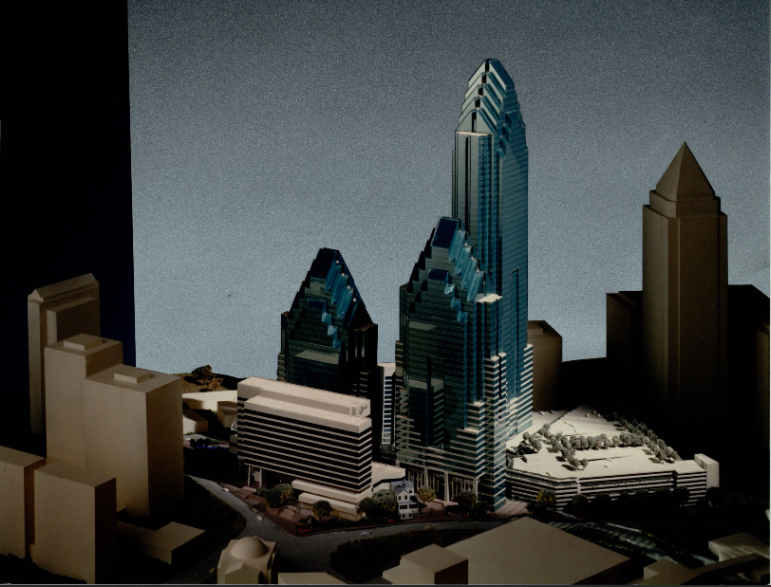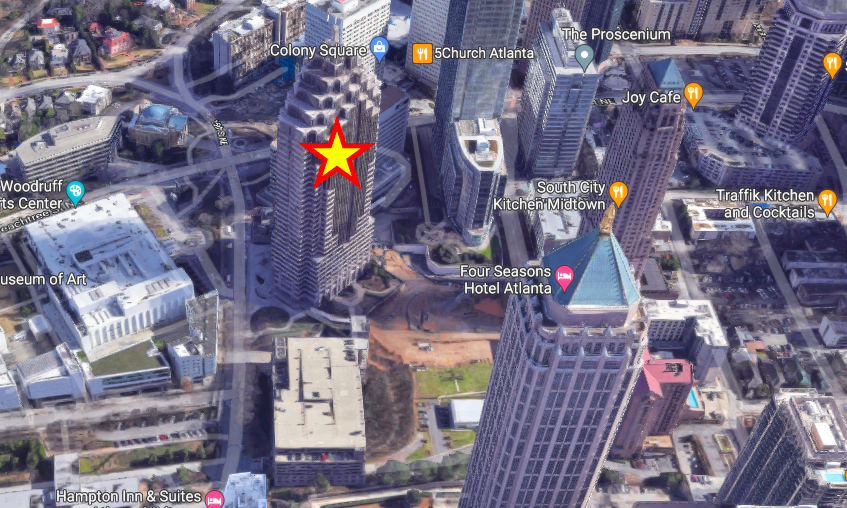Perhaps more than any other Atlanta subdistrict, Midtown has historically been the epicenter of monumental high-rise development proposals that didn’t happen, despite great expectations and years of media buzz.
While it’s hardly the scale of GLG Park Plaza—the so-called Rockefeller Center of the South dreamed up by a Swedish billionaire in 1991—a three-tower Midtown proposal called Promenade was unveiled to the world this month in 1987. It would still be defining the blocks west of Piedmont Park today, if it had come together as planned.
The AT&T-Landmark Group project was angling to take on the now-iconic IBM Tower (since renamed One Atlantic Center) for dominance of Midtown’s skyline, as the formerly residential district began to establish itself as downtown’s high-rise peer.
 Initial plans for the three-tower AT&T project at 1200 Peachtree in August 1987. This is the view looking southeast. Georgia State University Library/ Atlanta Journal-Constitution Photographic Archive
Initial plans for the three-tower AT&T project at 1200 Peachtree in August 1987. This is the view looking southeast. Georgia State University Library/ Atlanta Journal-Constitution Photographic Archive
The copper-topped IBM Tower, under construction at the time, stands 50 stories and 820 feet—still the third tallest building in Atlanta.
In August 1987, a three-tower version of the $500-million Promenade project was unveiled for local media and called “a grand civic gesture to Atlanta,” as one executive with developer Landmarks Group told the Atlanta Constitution at the time.
The complex, as initially planned, would be highlighted by a 57-story glass tower, which would have been the Southeast’s tallest office building. Overall, the plans were indicative of Atlanta's "skyline wars" of the time, as the newspaper's headline writers coined it.
Construction was scheduled to begin that December on the first phase—a 250-room hotel and the shortest, 31-story tower—with AT&T signed on to lease half of its 680,000 square feet. Eventually, according to developers, the 12-acre site would be lined with retail as a “town square” for AT&T employees and visitors.
By the following year, the development team hoped to be under construction on the 57-story office tower, as interest from tenants in 1987 was exceeding expectations, project leaders told the newspaper. Designs by TVS, AiGroup, and Turner & Associates were said to be “reminiscent of a crystal cathedral.”
Those designs were later tweaked to create tapering, lighted spires atop each high-rise; floor counts also changed before ground eventually broke.
 Refined plans for the Promenade towers of 40, 48, and 58 stories. Thompson, Ventulett, Stainback & Associates (TVS), and Ai Group
Refined plans for the Promenade towers of 40, 48, and 58 stories. Thompson, Ventulett, Stainback & Associates (TVS), and Ai Group
But the dazzling trifecta wasn’t meant to be.
In 1989, a 40-story Promenade tower opened that still stands as Atlanta’s seventh tallest building. That tower would have been overshadowed by two taller siblings, standing 48 and 58 stories.
But those plans were crippled by a commercial real estate recession in the early ’90s. The same financial turbulence of the era played a role in bringing down the massive GLG Park Plaza ambitions before they broke ground near today’s Biltmore Hotel.
 The 40-story Promenade tower that was actually built in 1989, as seen in recent years next to the long-stalled No2 Opus place site where taller Promenade towers would have stood. Google Maps
The 40-story Promenade tower that was actually built in 1989, as seen in recent years next to the long-stalled No2 Opus place site where taller Promenade towers would have stood. Google Maps
Nonetheless, the Promenade tower continues to stand out as a landmark from Atlanta’s decade-long skyscraper heyday, stretching from the early 1980s to the years leading up to the Centennial Olympic Games.
Nine of the city’s top 15 tallest high-rises today came together in that timeframe.
• 30 years later, remembering a legendary Atlanta megaproject that fell apart (Urbanize Atlanta)






